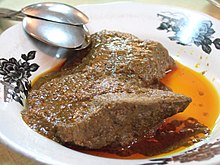 Rendang is a spicy meat dish which originated from the Minangkabau ethnic group of Indonesia,and is now commonly served across the country.One of the characteristic foods of Minangkabau culture, it is served at ceremonial occasions and to honour guests. Also popular in Malaysia, Singapore, Brunei, the southern Philippines and southern Thailand,
rendang is traditionally prepared by the Indonesian community during
festive occasions. Culinary expert often describe rendang as: 'West
Sumatra caramelized beef curry'. Though rendang is sometimes described as being like a curry, and the name is sometimes applied to curried meat dishes in Malaysia, authentic rendang is nothing like a curry. In 2011 an online poll by 35,000 people held by CNN International chose Rendang as the number one dish of their 'World’s 50 Most Delicious Foods' list.
Rendang is a spicy meat dish which originated from the Minangkabau ethnic group of Indonesia,and is now commonly served across the country.One of the characteristic foods of Minangkabau culture, it is served at ceremonial occasions and to honour guests. Also popular in Malaysia, Singapore, Brunei, the southern Philippines and southern Thailand,
rendang is traditionally prepared by the Indonesian community during
festive occasions. Culinary expert often describe rendang as: 'West
Sumatra caramelized beef curry'. Though rendang is sometimes described as being like a curry, and the name is sometimes applied to curried meat dishes in Malaysia, authentic rendang is nothing like a curry. In 2011 an online poll by 35,000 people held by CNN International chose Rendang as the number one dish of their 'World’s 50 Most Delicious Foods' list.Composition and cooking method
Rendang is rich in spices; next to main meat ingredient, rendang uses coconut milk (Minangkabau: karambia), and mixture of ground spices paste, which include ginger, galangal, turmeric leaves, lemon grass, garlic, shallot, chillies and other spices. These spices are called pemasak in Minangkabau language. Spices used in rendang are known as a natural antimicrobial substances and serve as natural organic preservatives. Garlic, shallot, ginger and galangal are known to have strong antimicrobial properties.That is why dry rendang if cooked properly could last for as long as four weeks.The authentic Padang rendang took hours to cook (usually four hours), that is why cooking rendang is time-consuming and requires patience.The pieces of meats slowly cooked in coconut milk and spices in perfect heat until almost all the liquid is gone, allowing the meat to absorb the spicy condiments. The cooking process changes from boiling to frying as the liquid evaporates. The slow cooking process allows the meat to absorb all the spices and to become tender.During the process, the meat in spicy coconut milk should be slowly and carefully stirred and turned over without burning or ruining the meat — well until all the liquids evaporated. This process is known as caramelization in culinary technique, in rendang case is not using sugar, but caramelizing coconut milk instead. Because of using numerous and generous amount of spices, rendang is known to having a complex and unique taste. Rendang is often served with steamed rice, ketupat (compressed rice cake), or lemang (glutinous rice barbecued in bamboo tubes), accompanied with vegetable side dishes of boiled cassava leaf, cubadak (young jackfruit gulai), cabbage gulai, and lado (red or green chilli pepper sambal).Cultural significance
Rendang is revered in Minangkabau culture, as it contains their philosophy, musyawarah; traditional discussion and consultation to the elders. The four main ingredients symbolize the wholeness of Minangkabau society:- Dagiang (meat), symbolize "Niniak Mamak": traditional clan leaders; such as datuk, nobles, royalties or revered elders.
- Karambia (coconut), symbolize "Cadiak Pandai": intellectuals such as teachers, poets and writers
- Lado (chilli), symbolize "Alim Ulama": clerics, ulama and religious leader. The hotness of chilli symbolize the strict sharia
- Pemasak (spices), symbolize the rest of Minangkabau society.
In Malay tradition such as those in Riau, Jambi, Medan in Sumatra or Seremban and Kota Bharu in Malay Peninsula, rendang is a special dish served in various traditional ceremonies; circumcision, marriage, and religious festival such as Eid ul-Fitr and Eid ul-Adha.
In Malay classical literature, rendang is mentioned in Hikayat Amir Hamzah as early as the 1550s.
Variations
Rendang is made from beef (or occasionally beef liver, chicken, mutton, water buffalo, duck, or vegetables like jackfruit or cassava). Chicken or duck rendang also contains tamarind and is usually not cooked for as long as beef rendang. Other Rendang variations:- Rendang daging: meat rendang, the most common rendang is made from meat of various cattle product; beef, water buffalo, goat, mutton or lamb
- Rendang ayam: chicken rendang
- Rendang itiak or Rendang bebek: duck rendang
- Rendang hati: cattle liver rendang
- Rendang talua or Rendang telur: eggs rendang, specialty of Payakumbuh
- Rendang paru: cattle lung rendang, specialty of Payakumbuh


Tidak ada komentar:
Posting Komentar